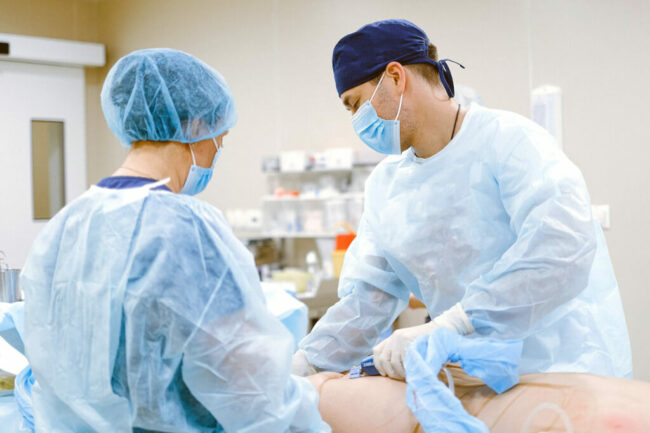Facts about liposuction
- Liposuction is a treatment that removes local fat deposits in selected areas
- It is among the most frequently performed cosmetic procedures
- It is not a substitute for losing weight in general, but a reduction of localized unwanted fat deposits in the subcutaneous tissue
- Liposuction only removes subcutaneous fat and not fat that lies within the muscles or between the intestines. Liposuction therefore only helps to a limited extent against abdominal obesity (apple shape)
Liposuction
Liposculpture and liposuction are two terms that are used synonymously with liposuction. Despite the fact that the method does not require large incisions on the body, it is considered surgery.
The procedure leaves only small wounds on the skin, but large wounds inside. Liposuction is among the most frequently performed cosmetic surgical procedures .
What is the purpose of liposuction?
The purpose of the procedure is to remove unwanted localized accumulations of fat on the body, which are difficult to get rid of through diet and exercise. The fat depots are often gender specific. Examples of such areas on the body are the stomach, waist, hips, upper arms, thighs and knees. Unwanted fat on other parts of the body can also be removed using liposuction.
How does the operation take place?
During the consultation, the plastic surgeon will decide together with the patient which fat accumulations can be removed. The elasticity of the skin is tested to see if there is a need to remove excess skin during or after the procedure, for example in surgery for loose abdominal skin . In most people, the skin has a certain ability to contract, as the skin is elastic. Elasticity decreases with age and can e.g. is reduced by prolonged smoking.
Liposuction can be performed under local anesthesia or under general anesthesia. The plastic surgeon injects salt water mixed with adrenaline, which is a vasoconstrictor, as well as possibly local anesthetic under the skin in the area to be liposuctioned. The fat is then sucked out through several small cuts in the skin using a tube connected to a suction mechanism. Suction is done from different holes in different directions to remove fat cells from several layers of fat in the body, and to make the result of the liposuction as even as possible.
The fat is collected together with the injected liquid in a container. When sufficient fat has been suctioned out, the openings are sewn up again or a piece of plaster is applied to the suction hole.
It can be tempting to ask the plastic surgeon to suck out as much fat as possible from the subcutaneous tissue. However, if too much is sucked out, it can be very difficult to correct any unevenness later. The most important thing is not what is sucked out, but what is left behind looks like. It is recommended in South Africa that liposuctions in otherwise healthy people do not exceed 3 litres. This is because larger liposuctions can create an imbalance in the composition of fluid and electrolytes in the body.
The duration of the procedure depends on which techniques the plastic surgeon uses and the amount of fat to be removed. It can take anywhere from one to three hours. Liposuction can be performed under local anesthesia or under general anesthesia .
Results of the intervention

After the operation, you will be given a compression bandage, which you must use for 2-6 weeks. This is done to avoid unevenness and loose skin. Most often, the threads are removed after 7-14 days.
If you maintain your weight, the result can last for a long time. New fat cells are not formed to replace those that the plastic surgeon has removed. But that does not rule out the possibility that you will gain more fat on your body – the size of each remaining fat cell can continue to grow and increase in volume.
Liposuction is not an alternative to diet and exercise. It is not a method to lose weight, nor is it a treatment for orange peel. The surgical technique only removes subcutaneous fat and not fat that lies within the muscles or inside the abdomen between the intestines. Liposuction therefore only helps to a limited extent against abdominal obesity.
Side effects after liposuction
You will usually have swelling and discoloration in the time after the procedure. Pain medication can reduce the discomfort. The swelling is worst in the first 1-2 weeks, but can last up to 8 weeks. The discoloration usually disappears after a few weeks. Most are back to light work after one to two weeks.
One should avoid heavy activity such as weight lifting, running or aerobics for the first month. On the other hand, you shouldn’t sit still all day either. Walking can prevent blood clots in the legs.
It can take 1-3 months and a few times a year before you get the final result of the liposuction. During this time, you can massage the treated areas to smooth out any unevenness. The scars are usually small and disappear on their own over time.
Possible complications
If your skin has poor elasticity, it will sag more than usual. This excess skin can be removed by the plastic surgeon at the same time as the liposuction or during a later operation.
Complications can occur with all surgery, but are rare. You may risk getting:
- Infection
- Damage to nerves
- Unevenness and numbness in the treated area. In most cases, the numbness will wear off over a few months
Liposuction also carries a small but serious risk of fluid in the lungs (pulmonary oedema), blood clots in the lungs, bleeding, fluid loss, heart failure and damage to internal organs. The more extensive the operation, the greater the risk. People with poor health (cardiovascular disease, diabetes and reduced immune system) are at greater risk.






